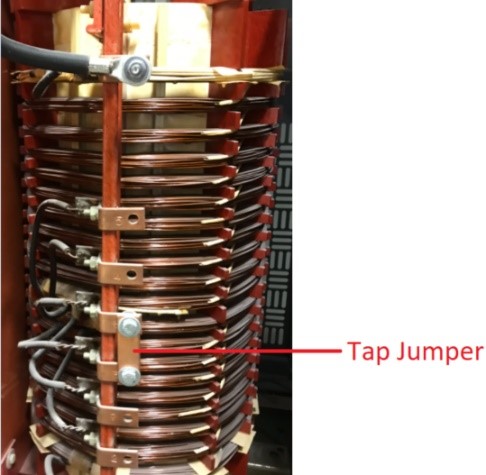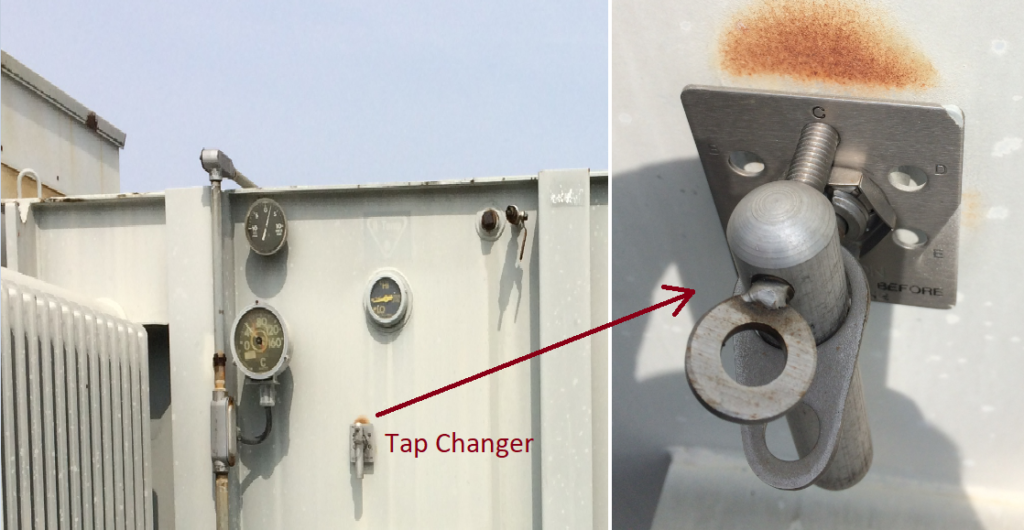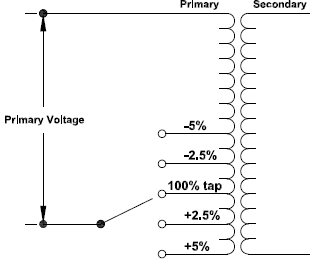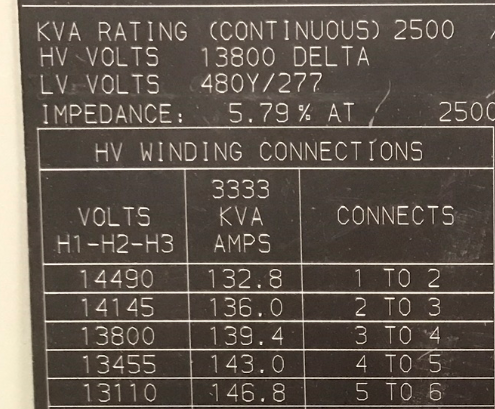Taps are provided on a transformer to adjust secondary voltage of power transformer for high or low voltage conditions. Common tap arrangements are +2.5%, +5% and -2.5%, -5% of the rated tap though some transformers could have more taps. Taps are usually provided on the high voltage winding as this winding has greater number of turns and finer control of voltage is hence possible. In addition, primary HV winding carries lesser current compared to secondary LV and is physically wound on top of secondary making primary side tap conductors smaller and more accessible compared to secondary side. Some situations when taps are useful for voltage adjustment are:
- Transformer with slightly off nominal voltage. Example, system voltage is 500V and transformer available is 480:120V.
- Primary side voltage has increased/decreased.

Due to one of the reasons above, it often becomes necessary to adjust transformer tap during or after commissioning of a power transformer. Figure 1 illustrates tap position for 13.2kV: 480V dry type transformer. Figure 2 illustrates another type of tap connection with solid busbar jumpers.
Link to AC Voltage Drop and System Power Factor

Tap changing could be Load Tap Changer (while the transformer is supplying load current) or No-Load Changer (transformer is de-energized). These are commonly designated as LTC or NLTC respectively. Transformers with Load Tap Changers (LTC) are usually but not necessarily liquid filled type. Reason for this is that LTC are usually applied at larger MVA transformers and larger transformers tend to be liquid filled.
When changing taps, it is important to recognize if higher /lower taps can be operated at full capacity or reduced capacity. Usually it is designated as ‘FC’ meaning Full Capacity or ‘RC’ for Reduced Capacity. Some data sheets also designate these are ‘ANFC’ (Above Normal Full Capacity) or ‘BNFC’ (Below Normal Full Capacity). ANFC indicates transformer can be operated at full capacity for positive taps (+2.5% etc.) while BNFC indicates transformer can be operated at full capacity for negative taps (-2.5% etc.).
Link to Voltage Regulation
Taps in dry type transformer:
Dry type transformer taps are often accomplished by using jumper cables between tap positions available. This is usually a manual process of disconnecting and reconnecting the tap cables. See figure 1 and 2.

Example of dry type transformer name plate is shown in figure 3. As can be seen, jumper cables need to be installed according to the table on right hand side. For nominal 13.2kV voltage, tap jumper needs to be between points ‘E’ and ‘F’ on the winding.
Taps in liquid filled transformer:
In liquid filled transformers, tap changing mechanism is buried in oil. This helps to make the entire mechanism compact, minimizing foot print compared to dry type unit.

There will be an external rotary switch by which tap positions can be mechanically changed, see figure 4 and 5. When switch is rotated, tap positions are internally changed according to the diagram shown.

Transformer Tap Changing: Basic Principles
Conventionally, normal rated winding is designated as 100% tap. There could be taps above 100% taps (called positive taps) or below 100% (called negative taps).


From above equation, for a given primary voltage V1:
- To increase secondary voltage, turns ratio must be decreased.
- To decrease secondary voltage, turns ratio must be increased.
Remember tap is usually provided only on primary HV winding and no adjustment of secondary winding is normally possible. This means to increase secondary voltage use fewer primary turns-decrease N1 and to decrease secondary voltage use more primary turns-increase N1.
Assume a transformer has 100% tap rating of 13,800V:480V as shown in figure 7.


In figure 7, tap% are not given but tap voltages are provided. Percentage tap for 14,145V and 13,455 etc. can be calculated as:


Turns ratio for each tap is calculated by dividing rated tap voltage from name plate with rated secondary voltage. For example, to calculate turns ratio for +2.5% tap we divide 14,145V/480V to get 29.47. To calculate secondary voltage for ‘actual’ primary voltage, divide actual primary voltage by turn ratio calculated for each tap. For example, if actual primary voltage for transformer shown in figure 7 is 13,450V then to calculate resulting secondary voltage for +2.5% tap, divide 13,450V/29.47= 456V. Calculator below can be used to calculate secondary voltage for each tap position based on actual primary voltage.
Summary
To raise secondary voltage, connect to a negative tap and to lower the voltage connect to positive tap. This is against conventional thought process and may confuse people. When we use -2.5% tap, we are effectively using only 97.5% of the winding. If we apply same voltage, then volts per turn for -2.5% is higher than volts per turn for 100% tap. Remember secondary side volts per turn is equal to primary volts per turn according to the basic principles of transformer. By connecting to a lower (negative) tap on primary, secondary side volts per turn is increased. Since secondary side number of turns is unchanged, secondary voltage will be raised. This is the basic principle of voltage increase/decrease from transformer tap changing.
Link to: Transformer Current Calculator
Link to: Voltage Unbalance Calculator
